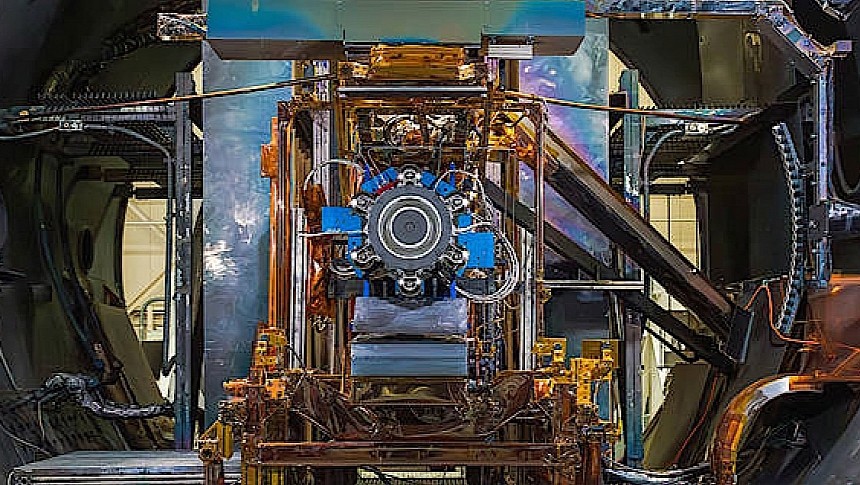Come 2025, NASA plans to have the first elements of the first-ever Moon space station in place. Called Gateway, the orbiting structure will be a staging point for missions down to the surface of the Moon and, with a bit of luck, ground zero for future missions to the Moon.
Announced in 2018, the Gateway will be a collaborative effort between several government-backed space agencies (NASA, ESA, and JAXA), but also several private companies like Northrop Grumman and SpaceX.
At the core of the space station will be the habitation and logistic outpost (HALO), the International Habitat (I-HAB), and the power and propulsion element (PPE). It's the latter component that's of interest to us today, because NASA just announced a major development concerning this critical piece of hardware.
The PPE is the module responsible for giving the space station power, communications, and, of course, propulsion. That means it'll hold the engines of the structure – three of them, which will be used to move the station around in orbit to serve whatever momentary missions need to be served.
The engines of the thing are being put together by Maxar Technologies, but they use tech supplied by Aerojet Rocketdyne and Busek. They are not chemical propulsion systems, but solar electric (SEP) ones, and the way they work is pretty simple: they take sunlight and xenon, convert them both into power, and that is used to generate "long-duration, highly efficient thrust."
How much thrust? According to NASA, the engines, which are officially called Advanced Electric Propulsion System (AEPS), will be twice as powerful as current electric means of propulsion. In all, 12 kW of propulsive power will be generated by a single thruster, making the Gateway the "most powerful SEP spacecraft ever flown. "
Earlier in April 2023 NASA announced it has completed the first stage of testing for the AEPS, and it's now knee-deep in qualification testing together with partner Aerojet Rocketdyne.
Two units of the thrusters will be used for different purposes. The first one started work in NASA laboratories in July, and will continue to do so for about a year. During this time, engineers will first try and see if they were built correctly, and then move on to subject it to vibration, shock, and thermal testing. A hot fire test of this thruster is also planned for later down the line.
The second AEPS will begin testing next year, and will be used to rate the hardware's resistance to wear. NASA will do so by testing the engine for about four years and a total of 23,000 hours.
That would kind of make NASA miss the 2025 deadline for launching the Gateway, but it won't. The agency will launch the PPE complete with its thrusters before the wear testing procedures here on Earth are complete.
We'll keep an eye out for further developments on what is perhaps humanity's most ambitious space engineering effort of our time.
At the core of the space station will be the habitation and logistic outpost (HALO), the International Habitat (I-HAB), and the power and propulsion element (PPE). It's the latter component that's of interest to us today, because NASA just announced a major development concerning this critical piece of hardware.
The PPE is the module responsible for giving the space station power, communications, and, of course, propulsion. That means it'll hold the engines of the structure – three of them, which will be used to move the station around in orbit to serve whatever momentary missions need to be served.
The engines of the thing are being put together by Maxar Technologies, but they use tech supplied by Aerojet Rocketdyne and Busek. They are not chemical propulsion systems, but solar electric (SEP) ones, and the way they work is pretty simple: they take sunlight and xenon, convert them both into power, and that is used to generate "long-duration, highly efficient thrust."
How much thrust? According to NASA, the engines, which are officially called Advanced Electric Propulsion System (AEPS), will be twice as powerful as current electric means of propulsion. In all, 12 kW of propulsive power will be generated by a single thruster, making the Gateway the "most powerful SEP spacecraft ever flown. "
Earlier in April 2023 NASA announced it has completed the first stage of testing for the AEPS, and it's now knee-deep in qualification testing together with partner Aerojet Rocketdyne.
Two units of the thrusters will be used for different purposes. The first one started work in NASA laboratories in July, and will continue to do so for about a year. During this time, engineers will first try and see if they were built correctly, and then move on to subject it to vibration, shock, and thermal testing. A hot fire test of this thruster is also planned for later down the line.
The second AEPS will begin testing next year, and will be used to rate the hardware's resistance to wear. NASA will do so by testing the engine for about four years and a total of 23,000 hours.
That would kind of make NASA miss the 2025 deadline for launching the Gateway, but it won't. The agency will launch the PPE complete with its thrusters before the wear testing procedures here on Earth are complete.
We'll keep an eye out for further developments on what is perhaps humanity's most ambitious space engineering effort of our time.











